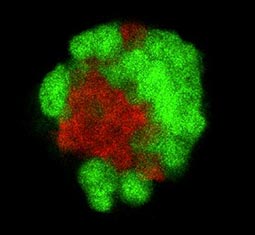August 23, 2012
Tense times: cortex tension sorts cells during gastrulation
Forces governing cell-cell contact formation and cell sorting analyzed in Science publication by group of Carl-Philipp Heisenberg

Embryos take their shape during development, forming the many different body shapes we see in the animal world. The group of Carl-Philipp Heisenberg at the Institute of Science and Technology (IST) Austria studies the forces determining development of the zebrafish embryo. In their new work published in Science, which is released online at Science Express today, they – together with the group of Ewa Paluch at the Max Planck Institute of Molecular Cell Biology and Genetics (MPI-CBG) in Dresden – studied how cells sort during gastrulation.
During gastrulation, cells sort into the three germ layers – ectoderm, mesoderm and endoderm – giving rise to the different structures and organs of the embryo. Sorting of cells into the correct germ layers is driven in part by differences in the ability of the different progenitor cell types to form contacts of certain size and strength. Two factors control the formation of cell-cell contacts: Cell adhesion (1) binds cells to each other through specialized adhesion molecules, while cortex tension (2), which is produced by the cells’ inner skeleton (cortex), pulls the cells towards a spherical shape, analogous to surface tension in bubbles. In their publication, the researchers analyzed the contribution of cell adhesion and cortex tension to cell-cell contact formation and cell sorting.
Previously, it was assumed that the two factors play opposing roles: cell adhesion would increase the contact, while cortex tension would decrease it. The scientists now show that germ layer progenitor cell-cell contact formation, and consequently cell sorting, are driven by differences in the ability of the different cell types to reduce cortex tension at the forming contact.
This reduction of cortex tension at the contact triggers the formation of a seemingly continuous cell cortex surrounding the adherent cells that pulls them towards a spherical shape, thereby increasing their contact size. The researchers further show that adhesion, in contrast to cortex tension, does not directly contribute to cell-cell contact expansion, challenging previous models of how adhesion functions in cell-cell contact formation and sorting.
What then, the researchers asked, is the role of adhesion? Germ layer progenitor cell-cell adhesion is mediated by Cadherin adhesion molecules binding to each other at the cell-cell contact. Cadherins are also mechanically coupled to the cells’ inner cortical skeleton. The researchers show that Cadherins function in progenitor cell-cell contact formation by mechanically coupling the inner cortical skeletons of the adherent cells at their contact. By doing so, Cadherins permit the formation of a continuous cell cortex surrounding the adherent cells. This coupling function of adhesion is not limited by the binding affinity of Cadherins to each other, as previously thought, but by the anchoring strength of Cadherins to the cortical skeleton. By manipulating the anchoring of Cadherins to the cortical skeleton in contacting progenitor cells, the researchers further show that this anchoring is critical for the different germ layer progenitor cell types to form contacts of different size and strength, and thus their sorting behavior.
The scientists also looked at the situation in the gastrulating embryo itself. Here, as observed in the ex vivo experiments, cortex tension is reduced at cell-cell contacts and cell-cell contact separation is associated with the dissociation of Cadherins from the cells cortical skeleton. Thus, the sorting of cells into their correct layers is probably driven by the same mechanisms as observed for cell sorting ex vivo, with cortex tension being the main factor. In contrast to previous models of cell sorting, the recently published work shows that cell adhesion plays mainly a supportive role in contact formation and cell sorting, while cortex tension is the previously unrecognized lead player.



